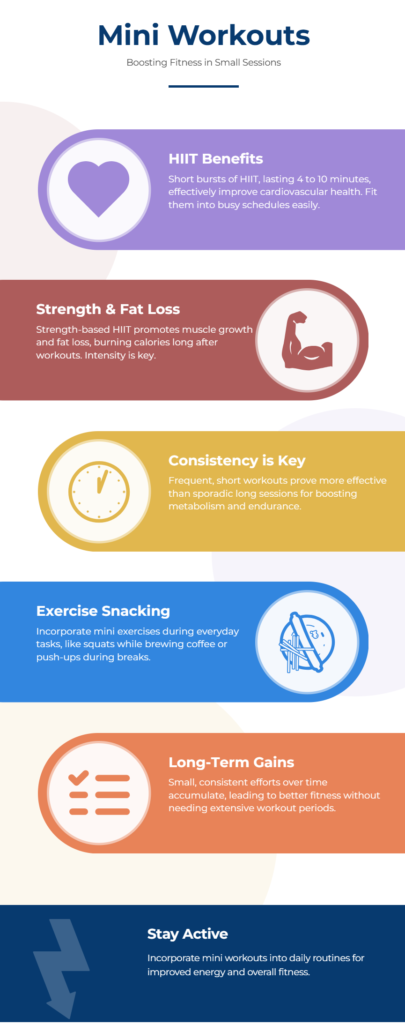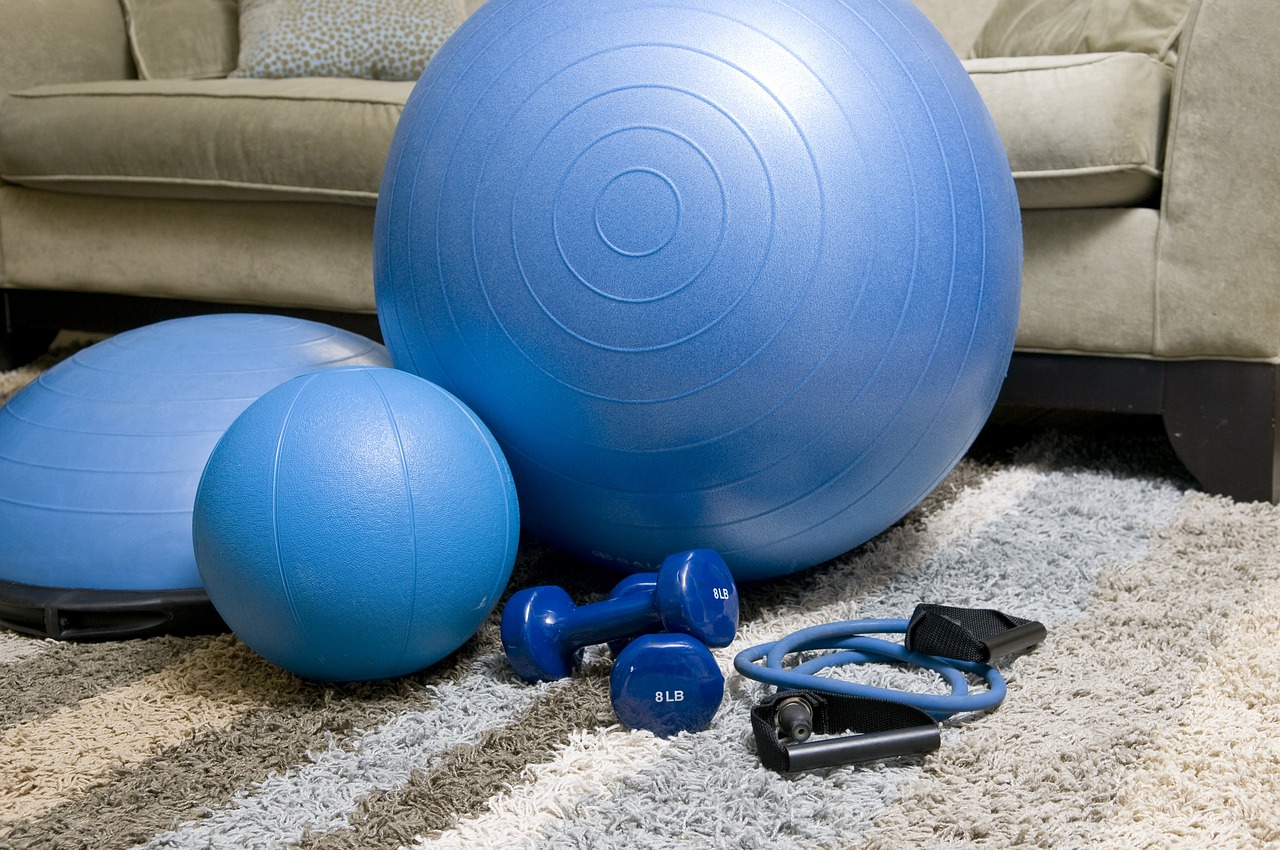Don’t miss a post. Click here to sign up for our free newsletter.
Estimated reading time: 8 minutes
Short Workouts for Big Results
How many times have you decided to skip a workout because you didn’t have enough time to do it “right”? Maybe you thought, “If I can’t get in a full hour at the gym, why bother?” This mentality is all too common, but it can often be a barrier to staying active. The good news is that you don’t need long, grueling workouts to reap the benefits of exercise. Recent research shows that short, intense bursts of physical activity—commonly known as exercise snacking—can be just as effective as longer workouts.
In this post, we’ll dive into the growing trend of mini-exercises, explore the science behind them, and provide tips on how you can incorporate these bite-sized workouts into your daily routine. Spoiler: It’s easier than you think!
The Shift Towards Exercise Snacking
Traditional exercise routines often emphasize lengthy sessions, such as an hour of steady-state cardio or a 90-minute strength training session. But with modern life’s demands—work, family, social commitments—it can feel impossible to carve out that much time in a day. Enter exercise snacking.
Exercise snacking refers to breaking down physical activity into smaller, manageable chunks throughout the day. Think of it like nibbling on nutritious snacks instead of having one big meal. You can perform short bursts of exercises that target different muscle groups or boost your heart rate without needing a gym or equipment.
A major factor fueling the popularity of exercise snacking is that research supports its efficacy. Studies show that performing short, high-intensity exercises several times a day can improve cardiovascular health, promote fat loss, and build muscle. The idea isn’t new, but it’s gaining steam as people look for ways to fit fitness into their busy lives.
The Science: Why Short, Intense Workouts Work
High-intensity interval Training (HIIT) is often at the center of the exercise-snacking conversation. HIIT involves alternating between short bursts of intense activity and rest or low-intensity exercise periods. A recent study published in the Journal of Physiology found that brief, high-intensity intervals—some lasting as little as four minutes—can improve cardiovascular health similarly to longer sessions of moderate-intensity exercise.
HIIT’s benefits don’t stop at cardio. In recent years, researchers have turned their attention to HIIT strength training, which involves performing strength exercises to the point of muscle failure or hypertrophy. Surprisingly, these short, intense sessions have proven effective for both fat loss and muscle gain. While HIIT was once seen as primarily a cardio technique, it’s now recognized for its potential to optimize muscle growth as well.
What makes this even more exciting is that HIIT-based strength exercises don’t require hours in the gym. A 20-minute HIIT session using bodyweight exercises like squats, push-ups, and lunges can be just as effective as traditional weightlifting routines that take twice as long. The key is intensity—working hard during those short intervals creates a potent stimulus for muscle growth and fat loss.
Breaking the “Perfect Workout” Myth
One of the biggest barriers to regular exercise is the idea that workouts need to be long, complicated, or performed in a gym setting to be effective. This couldn’t be further from the truth.
Perfection is the enemy of good—especially when it comes to exercise. While structured, hour-long workouts are great if you can fit them into your schedule consistently, they’re not the only way to improve your fitness. Exercise snacking shows us that something is always better than nothing. If you can squeeze in 5 or 10 minutes here and there, you’re still getting benefits that add up over time.
Think about it: Five minutes of bodyweight squats in the morning, 10 minutes of brisk walking during your lunch break, and another 5 minutes of high-knee jogging in the evening all contribute to your daily activity level. This approach can be especially helpful for beginners or those intimidated by longer workouts. Starting small and gradually increasing intensity allows you to build momentum and confidence.
Benefits of Exercise Snacking
Let’s take a closer look at some of the benefits of exercise snacking:
1. Improved Cardiovascular Health
Multiple short bouts of exercise throughout the day can improve heart health as effectively as longer workouts. One study found that just three 10-minute walks after meals can help regulate blood sugar levels, potentially reducing the risk of heart disease and diabetes.
2. Increased Fat Loss
Short, intense workouts have been shown to accelerate fat burning. A study in the International Journal of Obesity found that participants who performed 15-minute HIIT sessions lost significantly more body fat than those who engaged in moderate-intensity continuous exercise. The beauty of these mini workouts is that they keep your metabolism elevated long after the workout is over.
3. Muscle Gain and Hypertrophy
Research now shows that short HIIT strength sessions can stimulate muscle hypertrophy just as effectively as longer sessions. The key is working your muscles to the point of fatigue within each set. Exercises like push-ups, squats, and lunges performed at high intensity are perfect for building muscle in short bursts.
4. Better Mental Health
Exercise snacking has been linked to improvements in mental well-being. Short bursts of physical activity can increase the release of endorphins, improve mood, and reduce stress. This makes it a great option for combating the mental fatigue that often accompanies long workdays.
5. Sustainable for Busy Lifestyles
One of the biggest benefits of exercise snacking is its flexibility. You can fit in mini-workouts throughout your day without needing a gym membership or fancy equipment. Whether you’re at home, in the office, or even on a business trip, short bouts of exercise can be done anywhere.
How to Incorporate Mini Workouts Into Your Routine
If you’re ready to start exercise snacking, here are some practical tips to make it a part of your daily routine:
1. Start Small and Build Consistency
You don’t need to jump into hour-long workouts. Begin with just 5-10 minutes of high-intensity activity a few times a day. The goal is to build consistency, not to burn out. Over time, you can gradually increase the duration and intensity of your mini workouts.
2. Focus on Compound Movements
Compound exercises engage multiple muscle groups at once, making them highly efficient for short workouts. Exercises like squats, lunges, push-ups, and burpees are perfect for exercise snacking. These movements not only build strength but also elevate your heart rate, giving you a cardio boost as well.
3. Use Your Environment
You don’t need a gym to get in a good workout. Use what’s around you. Do calf raises while waiting for your coffee to brew, wall sits during a conference call, or a quick set of push-ups during a commercial break. The idea is to find small windows of opportunity to move your body throughout the day.
4. Incorporate Active Breaks
If you have a sedentary job, use exercise snacking to break up long periods of sitting. Every hour or so, get up from your desk and do a quick circuit of jumping jacks, squats, or marching in place. These short bursts of activity not only improve your physical health but also enhance focus and productivity.
5. Combine with Mindfulness
Exercise snacking can be a way to reconnect with your body and practice mindfulness. Instead of mindlessly scrolling through social media during breaks, use the time to move and focus on how your body feels. This can help reduce stress and improve mental clarity.
Recent Findings and Trends
As the popularity of exercise snacking grows, researchers continue to explore its benefits. A 2023 study published in The American Journal of Physiology found that exercise snacking can improve insulin sensitivity in as little as two weeks . Another emerging trend is the concept of microdosing exercise, which takes the idea of short workouts even further. Instead of a single 10- or 15-minute session, microdosing involves doing 1-2 minutes of exercise every hour throughout the day. This approach is especially appealing for those with highly demanding schedules.
Moreover, wearables like fitness trackers and smartwatches are making it easier than ever to track daily activity and ensure you’re getting enough movement. Features like hourly activity prompts encourage users to get up and move, aligning with the principles of exercise snacking.
Conclusion: Let’s Redefine What It Means to Be Active
Exercise snacking offers a fresh perspective on fitness that is accessible, flexible, and effective. It allows you to break free from the mindset that you need long, uninterrupted workouts to see results. By incorporating small, manageable bursts of exercise throughout your day, you can improve your cardiovascular health, build muscle, burn fat, and boost your mental well-being.
Whether you’re just starting your fitness journey or looking for a way to maintain your health amidst a busy schedule, exercise snacking might be the perfect solution for you. Remember: Consistency is key, and the best workout is the one you can stick to.
So, what are your thoughts on exercise snacking? Have you tried it, or are you interested in giving it a go? Let’s start a conversation! Feel free to share your experiences and tips in the comments.
Please see our post on body recompositioning for more information.
👉 Start today!
Check out The Seven Pillars of Sustainable Health and Wellness, an introduction to our overall wellness coaching strategy.
Subscribe to our free newsletter to receive more health tips right in your inbox, or schedule a free 30-minute 1:1 call for a personal consultation.
Short Workouts for Big Results | Cheat Sheet


2 Comments
Love this idea! Thank you for the thoughtful input of information!!
Thank you for your kind words, Eva. Much appreciated!